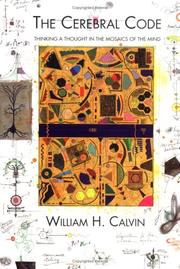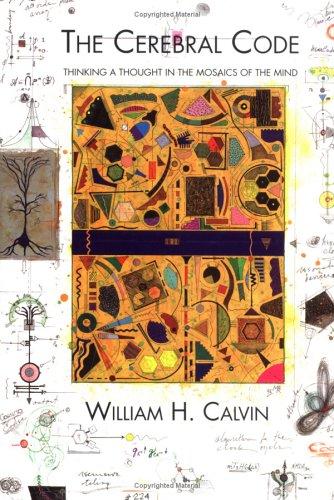Check nearby libraries
Buy this book

The Cerebral Code proposes a bold new theory for how Darwin's evolutionary processes could operate in the brain, improving ideas on the time scale of thought and action. Jung said that dreaming goes on continuously but you can't see it when you're awake, just as you can't see the stars in the daylight because it is too bright. Calvin's is a theory for what goes on, hidden from view by the glare of waking mental operations, that produces our peculiarly human consciousness and versatile intelligence.
Shuffled memories, no better than the jumble of our nighttime dreams, can evolve subconsciously into something of quality, such as a sentence to speak aloud. The "interoffice mail" circuits of the cerebral cortex are nicely suited for this job because they're good copying machines, able to clone the firing pattern within a hundred-element hexagonal column. That pattern, Calvin says, is the "cerebral code" representing an object or idea, the cortical-level equivalent of a gene or meme.
Transposed to a hundred-key piano, this pattern would be a melody - a characteristic tune for each word of your vocabulary and each face you remember.
Newly cloned patterns are tacked onto a temporary mosaic, much like a choir recruiting additional singers during the "Hallelujah Chorus." But cloning may "blunder slightly" or overlap several patterns - and that variation makes us creative. Like dueling choirs, variant hexagonal mosaics compete with one another for territory in the association cortex, their successes biased by memorized environments and sensory inputs.
Unlike selectionist theories of mind, Calvin's mosaics can fully implement all six essential ingredients of Darwin's evolutionary algorithm, repeatedly turning the quality crank as we figure out what to say next. Even the optional ingredients known to speed up evolution (sex, island settings, climate change) have cortical equivalents that help us think up a quick comeback during conversation.
Mosaics also supply "audit trail" structures needed for universal grammar, helping you understand nested phrases such as "I think I saw him leave to go home." And, as a chapter title proclaims, mosaics are a "A Machine for Metaphor." Even analogies can compete to generate a stratum of concepts, that are inexpressible except by roundabout, inadequate means - as when we know things of which we cannot speak.
Check nearby libraries
Buy this book

Previews available in: English
Subjects
Physiology, Consciousness, Cognitive neuroscience, Thinking, Thought and thinking, Brain, Natural selection, Memory, Cerebral cortex, Neurosciences, Neurosciences cognitives, Pensée, Cortex cérébral, Sélection naturelle, MEDICAL, Neuroscience, PSYCHOLOGY, Neuropsychology, Hersenen, Geheugen, Denken, Cognitieve psychologie, Neuropsychologie, Human Anatomy & Physiology, Health & Biological Sciences, Mental Processes, Central Nervous System, Cognition, Psychophysiology, Biological Science Disciplines, Learning, Psychological Phenomena and Processes, Nervous System, Natural Science Disciplines, Anatomy, Disciplines and Occupations, Psychiatry and PsychologyShowing 2 featured editions. View all 2 editions?
| Edition | Availability |
|---|---|
|
1
The Cerebral Code: Thinking a Thought in the Mosaics of the Mind
February 6, 1998, The MIT Press
Paperback
in English
0262531542 9780262531542
|
zzzz
Libraries near you:
WorldCat
|
|
2
The cerebral code: thinking a thought in the mosaics of the mind
1996, MIT Press
in English
0262032414 9780262032414
|
aaaa
Libraries near you:
WorldCat
|
Book Details
Edition Notes
Includes bibliographical references (p. [215]-238) and index.
"A Bradford book."
Classifications
The Physical Object
ID Numbers
Community Reviews (0)
Feedback?| August 2, 2024 | Edited by MARC Bot | import existing book |
| January 25, 2022 | Edited by ImportBot | import existing book |
| July 28, 2014 | Edited by ImportBot | import new book |
| April 28, 2010 | Edited by Open Library Bot | Linked existing covers to the work. |
| December 10, 2009 | Created by WorkBot | add works page |











